




Helping Kiwis streamline operations, boost engagement, and strengthen culture




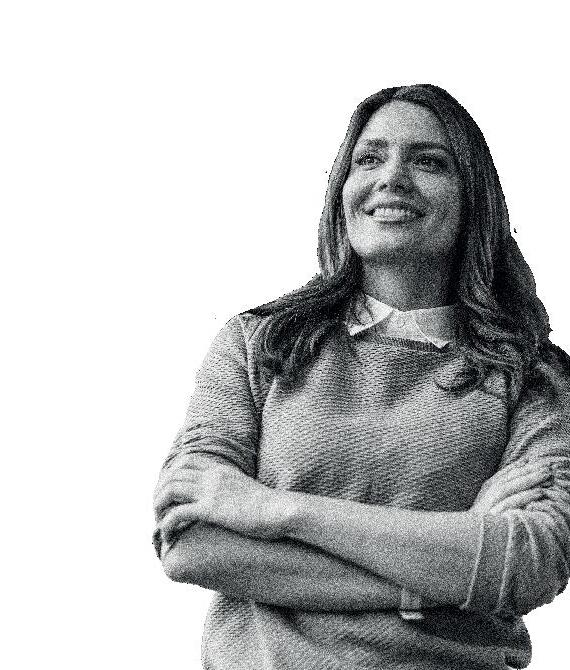

Book a demo
When I started my HR career in my early twenties, I was lucky enough to be selected for a role on The Boots Company graduate programme in the United Kingdom. Although I was selected as an HR graduate, the company had the foresight to expose all graduates to all parts of the business from day one. Training included finance, marketing, IT and operations. I would often scratch my head, wondering why on earth I was being trained to understand profit-and-loss statements or to come up with ideas for a new marketing initiative.
Fast forward over two decades, and I now fully understand the power of business acumen for HR people. I could talk the language of my managers. And, of course, it was more than just keeping up with the numbers. It gave me context for the decisions my managers wanted to make, and it helped me to talk to employees about how the people strategies linked
to the broader business goals. I was able to ask the right questions and be seen as a credible business partner.
This is what this issue is all about. Not just gaining business acumen, but also how HR professionals can enable new opportunities that align with the business or organisation they are working in. We feature an article by Allana Coulon of MartinJenkins on labour market changes we can expect over the next five years and what that means for workforce planning. I caught up with Dan Te Whenua Walker on enabling authentic opportunities, breaking barriers and changing corporate culture. And we hear from Terry McCaul and Brian Yee about the opportunities ahead for highperformance organisations.
We also introduce a new column in this issue: Executive Perspectives. We ask top CPOs for their take on our magazine theme each issue. First up, Marc Figgins, CPO at Westpac New
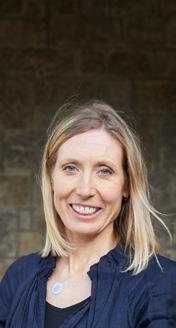
Zealand, offers his view on how HR can enable new opportunities.
And, if you’re interested in upskilling your commercial skills, check out HRNZ’s new online course coming in February 2026: Commercial Conversations for HR Leaders
From the entire magazine team, I wish you a joyous and restful holiday season.
Kathy Young
Editor
Kathy.Young@hrnz.org.nz
EDITOR
Kathy Young
Ph: 021 0650 959
Email: kathy.young@hrnz.org.nz
ADVERTISING & SPONSORSHIP
Nikita Barends
Ph: (04) 802 3954
Email: nikita.barends@hrnz.org.nz
MARKETING & COMMUNICATIONS
Georgia Wormald
Ph: (04) 499 2966
Email: georgia.wormald@hrnz.org.nz
DESIGN
Jen McBride, Jn Creative
Email: jen@jn-creative.co.nz
PROOFREADER
Jenny Heine
Email: jenny@heine.co.nz
SUBSCRIPTION ENQUIRIES
Email: comms@hrnz.org.nz
PUBLISHER
Human Resources is published quarterly by Human Resources New Zealand PO Box 11-450, Wellington Ph: 0800 247 469
comms@hrnz.org.nz
hrnz.org.nz
nz.linkedin.com/company/hrnz
instagram.com/hrnzphotos
The views expressed in Human Resources are not necessarily those of Human Resources New Zealand, nor does the advertisement of any product or service in this magazine imply endorsement of it by Human Resources New Zealand.
Copyright © Human Resources New Zealand Inc. Vol 30 No: 4
ISSN 1173-7522
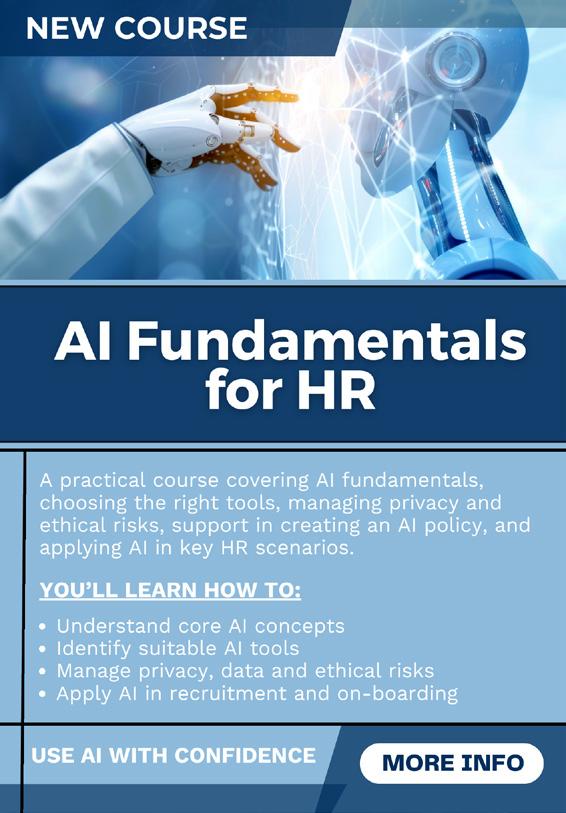
“
Am I making a difference here?
That question was top of mind for me when I first started in an HR role. Only in my 20s, I was responsible for designing and delivering training courses for team leaders and managers. I loved the work and thought my content was great. I was convinced I was going to change the world when my eager trainees returned to their workplaces and applied all their new skills. I would visit every one of them back in their workplace within 30 days to check on how they were applying their new skills. Most of these people were older than me, and I quickly learned they were surprised at the expectation that they would apply anything they had learned in the course. I was humoured with little success stories, but soon realised that making a difference was a little more complicated than I expected. These early experiences didn’t discourage me; they just taught me to think a lot harder about the context I was working in and how to influence change. Three of the core capabilities within the HRNZ framework, “The Path”, are: Read a Room or Situation, Bringing People on the Journey and Solving Workplace Problems. These are the capabilities that I knew I needed to develop if I was to become successful in my role.
Within the current economic environment in Aotearoa New Zealand, these capabilities are more important than ever for HR professionals.
Many of our members have found themselves in that familiar role of helping their organisations ‘right-size’ over the past two years. This hasn’t just involved reducing employee numbers but also cutting back on ‘non-essential’ initiatives. The combination of these things has, in many cases, affected workplace culture. So, what happens as economic conditions improve?
Organisations will want to invest and grow as market opportunities begin to emerge. Being ready and getting ahead of the curve are critical in a turning market. HR professionals will know that we still have talent shortages for many key-skilled roles and that, as conditions change, competition will increase for available talent. The lead times for recruiting talent are long, even with the help of artificial intelligence. Does your employee value proposition stack up after any clawbacks? Is your new flexible work policy fit for purpose to optimise your ability to attract and secure talent?
An ability to read the situation for your own organisation helps to answer those important questions. A healthy curiosity about what’s happening in the organisation’s environment and

an understanding of where opportunities are emerging ensures that people capabilities are available to realise these opportunities. Long-term workforce plans are necessary, but so is the ability to respond to market changes in an uncertain world.
Moving from the role of ‘chief retrenchment officer’ to ‘chief growth officer’ is especially challenging for the HR professional, in part because they are not typically seen this way. However, this is the place where the most value can be added and where HR professionals can make a real difference in the current environment.
The optimist in me says the economy will soon take a positive turn. This won’t happen magically. It will be from the innovation and energy that New Zealand organisations apply to identifying and realising new opportunities. HR professionals have a significant role to play. I’m confident we’re up to the challenge.

30 What’s on the workforce horizon?
Allana Coulon, from MartinJenkins, explores labour market changes expected in the next five years and what they mean for HR professionals planning for future workforce needs
34 Culture meets commerce Editor Kathy Young speaks with Dan Te Whenua Walker, Microsoft’s Global Co-Chair of Indigenous, to learn about breaking barriers, changing corporate culture and enabling opportunities
38 Redefining highperformance organisations Terry McCaul lays down a challenge to HR professionals to test their own assumptions and offers a solution to guide organisations towards sustainable success
42 Why HR strategies fail – and how to get them aligned Brian Yee, Managing Director of MSH Consulting, explores the common pitfalls that prevent HR from becoming a strategic partner, and offers a practical framework for positioning HR as a critical driver of organisational success





Shaping the Profession
1 From the Editor Kathy Young
3 Top of Mind
Chief Executive Nick McKissack shares his thoughts
8 Quick Reads
The latest updates to keep you current in the world of HR
10 40 Years, 40 Stories
We reminisce on some of the stories of HRNZ’s 40-year journey
14 Accredited Members
HRNZ caught up with a newly accredited Chartered Member and Accredited Member, to share their career highlights and insights
16 Executive Perspectives
We ask Westpac New Zealand CPO Marc Figgins for his views on HR enabling new opportunities
18 Employment Law Update Holidays Act changes explained – Jack Rainbow, Dundas Street Employment Lawyers, outlines the main proposed changes to the Holidays Act 2003, the practical implications and the issues that may persist, despite reform
20 Research Update
Research Sparks: Turning intellect into HR impact – HRNZ’s new Research Sparks competition showcases New Zealand’s next generation of HR thinkers
22 Immigration Law Update Enabling new opportunities for hiring migrant workers – Rachael Mason, Lane Neave, outlines the main changes that enable employers to bring migrants into their organisations
24 HR’s Role in Financial Wellbeing
Supporting an ageing workforce to retire with confidence – Jeff Ruscoe, at AMP, outlines how HR professionals can help their people retire with confidence, building engagement across all generations
26 PD Spotlight
AI Fundamentals for HR – Chelsea Mapp, HRNZ, explains why the AI Fundamentals for HR course is a must for HR professionals right now
46 Dear Human Resources... Aidan Stoate, from Inspire Group, shares his heartwarming insights into being a people leader
Check out our banners and footers!
Our articles are all tagged with the levels (see above), from our new Capability Framework, The Path
For more information, check out our website.
Thinking about becoming Chartered but unsure where to start?
Charter Assist is a personalised support service designed to guide eligible HR professionals through the Chartered Member application. You’ll receive up to 4 hours of expert assistance from an experienced HRNZ coach to help you:
Understand what’s required at each step
Complete the self-assessment
Develop an executive summary of your experience to support your application Select and brief your referees and more...
Whether you ' re feeling unsure, time-poor, or just want an experienced sounding board –Charter Assist can help you put your best foot forward.
More information Register your interest



FORTY YEARS OF HRNZ
Members of HRNZ gathered on the evening of 16 October in Wellington to celebrate HRNZ’s 40th anniversary. The event featured short speeches from esteemed members of

the HR community, including Geoff Summers, Distinguished Fellow of HRNZ; Elena Calvert, CMHRNZ and current HRNZ National President; and Poppy Fogarty, AMHRNZ and HRNZ Student of the Year 2025.

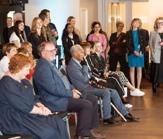
Presentations were also made to recently qualified Distinguished Fellows. It was a fantastic occasion to toast and celebrate the incredible people who have shaped HRNZ over the past 40 years, as well as those who will carry us into the future.
THRNZ PERSON OF THE YEAR PRESENTS AT UNIVERSITY OF AUCKLAND’S IGNITE EVENT of universities in preparing future-ready workforces.
he University of Auckland’s Ignite 2025 thought leadership series, Thriving in tomorrow’s workforce, saw Dr Deepika Jindal, Programme Director for the Master of Business Management and recipient of HRNZ’s Leadership Award 2025, talk about how artificial intelligence is reshaping the skills we value and the evolving role
HThe multidisciplinary panel shared how job crafting and career crafting can help employees and leaders thrive in an artificial intelligencedriven workplace.
To hear more from Deepika Jindal and the other panellists – including keynote speaker Sir
QUARTERLY MARKET UPDATES IN PARTNERSHIP WITH LIVE REM employees. These insights will be shared each quarter to support informed decision-making and effective workforce planning.
RNZ has established a strategic partnership with LiveRem to provide members with quarterly market updates offering comprehensive, datadriven insights into workforce trends across New Zealand.
Through this collaboration, LiveRem supplies aggregated data on important HR metrics, including employee turnover, new hires, total headcount changes, wage movements, and the ratio of HR professionals to total
Findings from the inaugural update indicate that most organisations are currently focused on maintaining existing headcount, with top priorities being internal capability development, talent retention, and employee health, safety and wellbeing.
Ashley Bloomfield – watch on demand at auckland.ac.nz.

While views on the economic outlook varied between stability and moderate growth, wage movement expectations were generally modest, averaging around 2 per cent to 3 per cent. Together, HRNZ and LiveRem will continue to deliver these quarterly market updates, providing members with valuable benchmarking data and visibility in the evolving HR landscape.
The Health and Safety Special Interest Network was established in August 2025 to foster collaboration and share best practice across the HR community, with a shared goal of making work better for everyone.
The network has already grown to more than 200 members, and its first event on 8 October 2025, Where Human Resources and Health and Safety Naturally Overlap – and How to Work Together, drew strong engagement, with over half the network registering to attend.
Featuring speakers Megan Blakely, Lecturer in Industrial and Organisational Psychology at the University of Canterbury, Simon Lapthorn, Employment Lawyer and Partner at Kiely Thompson Caisley, and Mike Cosman, Partner at Cosman Parkes, the session explored the intersection between HR and health and safety. It examined how organisational psychology can reframe safety as a lever for performance, culture and wellbeing, an approach particularly relevant in low-resource environments.

TAKE A BREAK –READ AND LISTEN
Ready for a mini break from your desk? This book and podcast provide valuable guidance to help you in your HR role.

PODCAST: HR Chats with Te Radar New episode: Ko wai au – Who am I? The journey of assimilation and the rediscovery of identity. Featuring: Chris Maika, Founder, Ruku ki te Ako
In the latest HRNZ HR Chats podcast, host Te Radar sits down with Chris Maika (Te Arawa, Ngāpuhi) for a powerful and deeply personal conversation exploring assimilation, identity and belonging in Aotearoa New Zealand’s workplaces.
Chris shares his journey of assimilation and the moments that led him to rediscover his cultural identity, and what it truly means to show up authentically at work. Drawing on over 20 years in learning and development – including his mahi through Ruku ki te Ako – Chris offers valuable insights for HR professionals on how we can create environments where people feel seen, safe and connected.
This episode challenges us to reflect on how we shape cultures of inclusion, and what it takes to move from assimilation to authenticity. Join the kōrero here
Looking ahead to 2026, the network will continue to build momentum, hosting events that explore the evolving role of HR in creating safe, healthy and sustainable workplaces.

BOOK: Elegant Leadership by Kristen Cooper Elegant Leadership is written by Kristen Cooper, DistFHRNZ and prior National President of HRNZ.
Kris has over 30 years of experience in middle and senior management positions in the fields of planning, HRM, marketing, training and consultancy.
Elegant Leadership offers Kris’s methodology for leadership practice that is clear, simple and fit for purpose. It brings intentionality to day-to-day leadership, identifies core behaviours that work well and provides a framework for further challenge.
The book is about finding a balance between the styles of pleasing people and needing to be right. Using the ‘knowing-doing-being’ model of leadership, it promotes goal-setting and regular reflection in the quest for selfawareness and insights into what works best in a given context.
Leadership involves more than knowing what to do in difficult times and big moments. Effective leadership is often about the micromoments, and is usually judged based on small actions that accumulate over time.
Elegant Leadership contains an A–Z of key words that promote actions that are simple, clear and effective, and offers workspace for personal contemplation, planning and regular reflection. It is suitable for HR leaders, frontline managers and senior leaders.
Elegant Leadership is available from bookstores or direct from kayceeprojects.co.nz (RRP $40).
40 40years, stories
In 1985, the Institute of Personnel Management was formed. In 1995, the organisation was renamed the Human Resources Institute of New Zealand. In 2025, HRNZ celebrates its 40 years of people-powered success. In each issue of Human Resources magazine this year, we share 10 remarkable stories from past and present members, charting our four decades of the HR profession.
CMHRNZ, Chief Corporate Services Officer for Pāmu
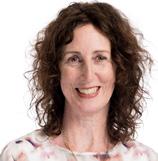
HOW CAN HRNZ BUILD ON ITS LEGACY IN THE NEXT 40 YEARS?
Congrats to everyone involved in making HRNZ the sustainable entity that it is. It has grown in leaps and bounds, and the effort and passion that have gone into it have now ensured it remains relevant. To keep building on that positive trajectory is essential. In a world full of change, our profession can add a level of depth, commercial savviness and humanity like no other. Having an organisation like HRNZ to help promote our work, connect us all with a common purpose and keep the focus on always growing is an absolute necessity.
CMHRNZ, Chief People Officer at the New Zealand Qualifications Authority

CMHRNZ, National President, HRNZ and Recruitment Manager, University of Otago
2022 HR Student of the Year, Relationship Manager, Vets Central New Zealand 32 33 34


WHO ARE YOUR UNSUNG HEROES OF HRNZ?
The HRNZ team. A small but mighty group of individuals who work hard behind the scenes to ensure that members reap the benefits of an organisation, whether it’s providing access to foundational best practice, introducing new ways of thinking and innovative ideas in the realm of all that is Human Resources or offering opportunities for mentees and mentors to connect. LOVE YOUR WORK!
Ioften think about how different our profession would be without your vision. You created more than an organisation, you built a community that has supported, challenged and inspired so many of us. Your work gave HR professionals a place to belong, to grow and to be heard. Your legacy continues to shape many a journey, and I hope you’re proud of what HRNZ has become.
WHAT’S YOUR BEST MEMORY OF HRNZ?
My best memories during my time with HRNZ are the HRNZ Award nights each year. I’ve been attending since 2021. I love the opportunity to come together, celebrate the profession and to hear about all the incredible work HR people and teams are doing within their workplaces. Setting aside time to celebrate each other and build relationships within our profession makes the Awards night a wonderful and fulfilling event. I find the HRNZ Awards so motivating; they really show that anything is possible in this amazing profession.
CMHRNZ, Group HR Manager, VIP Group

WHAT IS YOUR BEST MEMORY OF
HRNZ
My favourite memory of HRNZ was actually the process of becoming Chartered. I felt supported not only by the Canterbury committee members but also by the chief executive of the organisation. No question ever felt too small, and The Path gave me the guidance I needed to see if I was ready to take that step. This experience has left me with a lasting impression of HRNZ as an organisation that supports its members at every level and facilitates meaningful connections across the motu. I believe it’s these small but powerful moments that create a lasting impact and truly reflect what HRNZ means to its members.
CMHRNZ, Head of People and Culture, Connetics
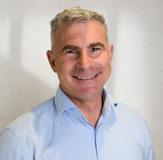
HOW CAN HRNZ BUILD ON ITS LEGACY IN THE NEXT 40 YEARS?
By recognising that innovation is fundamentally a human endeavour, enabled – not driven – by technology. The future of our profession will depend on how well we combine digital tools with the uniquely human capabilities of empathy, creativity and judgement. HRNZ has an opportunity to lead by fostering communities that share ideas, experiment boldly and learn together. By keeping people at the centre while leveraging technology as an enabler, HRNZ can ensure that progress enhances connection rather than replaces it. This balance will define the next 40 years of meaningful impact for our profession.
2025 HRNZ Student of the Year, Generalist Graduate at Z Energy

WHAT’S YOUR BEST MEMORY OF HRNZ?
M y most memorable HRNZ moment was attending the 2025 HRNZ Awards. The atmosphere and energy were unlike anything I had experienced before. It was inspiring to be surrounded by passionate HR professionals making a real impact. The event was extra special because it celebrated HRNZ’s 40th anniversary and brought together people who share a love and passion for HR. I attended as a finalist for the HRNZ Student of the Year award and was fortunate to be named the recipient. Hearing my name announced was surreal. I felt so excited and motivated to begin my HR career journey as a graduate.
CMHRNZ, HR Manager, Kinross

CMHRNZ, Chief People Officer, Genesis
CFHRNZ, Professor at School of Management and Marketing, Te Kunenga Ki Pūrehuroa Massey University 38 40 39
WHO ARE YOUR UNSUNG HEROES OF HRNZ?
My unsung heroes of HRNZ are the incredible mentors across the network who generously give their time, wisdom and heart to support the next generation of HR professionals. These mentors do more than share knowledge; they listen, challenge and guide their mentees through the complexities of our profession and the personal growth that comes with it. Their impact often goes unseen, but it is deeply felt. They help shape confident, values-driven practitioners who are better equipped to lead with empathy and purpose. Their quiet dedication supports a stronger, more connected HR community.
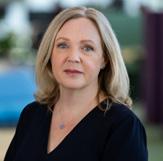
WHAT MESSAGE WOULD YOU LIKE TO SEND TO THE FOUNDERS OF HRNZ?
My message to our founders would be one of gratitude for the foundation you laid and the support it has offered throughout my career. Over the course of 25 years in the HR profession, I have greatly valued the role HRNZ has played in shaping my career. The professional development opportunities provided early on gave me a grounding for my confidence and capability as a leader. The networking, recognition and shared learning experiences have not only broadened my own perspective but also deepened my commitment to helping others grow. Being part of a community has been a source of connection, insight and inspiration, reinforcing the impact HR can have on people and organisations.

WHAT’S YOUR BEST MEMORY OF HRNZ?
Iarrived at Massey University from the United Kingdom in September 2008 and was immediately introduced to HRNZ by one of the HR managers in my class, Lisa Dickson. Before the year was out, I was on the Auckland branch committee, where I stayed for nine years, then on to the Academic Branch, where I am currently Secretary! Lisa’s energy and enthusiasm turned out to be a common trait in the HRNZ community; a great bunch of people doing fantastic work, and fun to be around.
Human Resources
magazine caught up with Vis Berry (Accredited Member) and Sonia Morrison (Chartered Member) to discuss their paths to HRNZ accreditation and their thoughts on the role of HR in Aotearoa today.
What have been your career highlights to date?
I am most excited about the breadth of work that I have been able to do, exploring various pockets of people and culture, including reward, generalist HR, and now employee relations.
In my current role, I’ve had the opportunity to work across a wide range of employee relations matters and have learnt a great deal. I enjoy being in a role where I can problem-solve people challenges, while also having the chance to dive into the details of employment law.
The professional services industry is a unique one to work in, and I enjoy how fast-paced and unexpected the work can often be. It is very interesting to work across a spectrum of teams that all deliver very different solutions to clients.
What inspires and motivates you in your career and why?
I’m motivated by the work I do in employee relations because
it’s a dynamic space where we often support people who may not be their best version of themselves. This creates opportunities for problemsolving and creativity, which I find both challenging and rewarding. I enjoy managing cases and workshopping creative solutions. Seeing a positive outcome at the end is always satisfying. I believe a humanistic approach to each individual can help to create an environment where people can truly thrive at work.
What do you see as the challenges facing the industry and the HR profession?
A significant trend in the talent function is the shift towards proactive leadership. Talent and employee relations teams are expected to be focused on anticipating risks, particularly in supporting employee wellbeing, and enabling talent to thrive before issues escalate formally. For example, employee relations professionals now play a bigger role in identifying and responding to psychosocial risks, and ensuring that fair and inclusive practices are embedded across the organisation. This expansion is broad and includes processes that have traditionally been seen as routine, such as performance management.
How has HRNZ membership helped your career?
HRNZ has helped my career in many ways! I love having the opportunity to meet others in

their field, especially those who work in different industries. It’s great to be able to come back from branch events, learn something, and then share this with my team and apply it to my work.
Please describe your journey towards becoming a Chartered Member. How was the experience?
The Accredited Professional Membership was something that I had been considering for some time, even when I was an HRNZ Student Member. It is great to finally go through the process. As a member of HRNZ, I really enjoy the different branch events and networking opportunities. I’m able to think about how these events and the L&D opportunities I receive at work can help me build my domains of knowledge, so I can feel confident using them. It’s also a great signal to employers that you are committed to staying up-to-date in the dynamic world of people and culture.
What have been your career highlights to date?
One of the most meaningful highlights in my career was leading the rollout of a Māori Masterclass programme at The a2 Milk Company, in partnership with Andrew Baker from Tika Learning. As a New Zealandfounded business, it was important for us to honour our heritage and deepen our team’s understanding of Māori culture. It was a powerful experience that strengthened cultural awareness and connection across the business.
We have also seen our New Zealand business grow quickly in response to mobilising a critical strategic pillar of our business. This has meant building and growing capability and evolving the organisational and operational model. Partnering closely with our chief supply chain officer to fulfil an important strategic objective for a2MC has been very satisfying and required the design and implementation of initiatives. It has resulted in measurable commercial outcomes, which have been professionally fulfilling.
What inspires and motivates you in your career and why?
I’ve always been drawn to roles that centre on people, solving problems, building relationships and creating environments where others can thrive. What motivates me most is seeing the real impact our People and Culture team can have across
both individual experiences and the wider organisation. I’m inspired daily by the energy and passion of our teams. Together, we are shaping a culture that champions growth, connection and high performance.
What do you see as the challenges facing the industry and the HR profession?
HR professionals in New Zealand are navigating increasing complexity around employee expectations, flexibility, wellbeing and equity, while also managing organisational pressures like budget constraints and constant change. Balancing strategic goals with human needs requires us to be both advocate and realist.
How has HRNZ membership helped your career?
HRNZ has been instrumental in helping me stay connected to the wider HR community. It has provided access to resources, thought leadership and a network of professionals who share a passion for making a difference. Especially in regional areas, that sense of connection is invaluable.
Please describe your journey towards becoming an Accredited Member. How was the experience?
Becoming a Chartered Member was a reflective and rewarding experience. It gave me the opportunity to acknowledge the depth of my experience and the impact I’ve had in strategic roles.

I was the first to go through the new Charter Assist programme and couldn’t recommend it highly enough. Chelsea was an incredible support, guiding me through each step. The process itself isn’t overly demanding, but having that support made it much easier, especially given how time-poor I was. It turned what could have felt overwhelming into something smooth and achievable. It’s a fantastic initiative that makes Chartered Membership more accessible for busy professionals.
What are your next steps now that you are a Chartered Member?
I’m focused on growing as a strategic leader, mentoring emerging HR professionals, and contributing to thought leadership in areas like workforce strategy and organisational culture.

In our new column, we seek the views from top Chief People Officers on our theme for the magazine each issue. First up, Marc Figgins, CPO at Westpac New Zealand, offers his take on how HR can enable new opportunities.
QWHAT DOES ‘ENABLING NEW OPPORTUNITIES’ LOOK LIKE TO YOU AS A CPO?
It’s about having a wide-angled lens where you and your team are continuously driving and championing a culture of innovation, scanning the horizon for ways to lift productivity, customer and employee experience. It also requires extreme curiosity and a willingness to challenge the status quo.
QHOW DO YOU KEEP AHEAD OF THE CURVE AT WESTPAC WHEN IT COMES TO THE PEOPLE AGENDA?
We are certainly in a period of incredible change: new and rapidly emerging technologies, changing customer needs and workforce trends. I encourage my team to be very interested in everything but also very thoughtful about what will work for our organisation and ultimately what will deliver for our customers. You don’t need it all, you can’t afford it all, and you probably can’t deliver and digest it all from a change perspective. The key is a few things, done well at scale, that are enduring and make a difference for customers. It’s also critical you get your culture right, from the top down. Culture should be grounded in a genuine values and behaviour set that your people have helped define and that they believe in.
QHOW DO YOU ALIGN YOUR PEOPLE STRATEGY WITH THE BUSINESS STRATEGY?
We start with the business strategy first and then determine how we can deliver for customers through our people. We’re investing heavily in our Banker Academy to uplift capability, to meet changing customer needs. In addition, as functional experts, we deliver innovative people initiatives at an enterprise level through our Employee Experience team. These include our enhanced Employee Value Proposition “Double You” that looks not only at our employee benefits or ‘work perks’, but also the continuous improvement of all aspects of the employee lifecycle.

WHERE CAN HR PEOPLE GET THE BEST RETURN ON INVESTMENT WHEN IT COMES TO FACILITATING NEW OPPORTUNITIES FOR THEIR ORGANISATIONS?
Listen to your business leaders. Understand their needs deeply. Start with the customer and work back. Link your people initiatives to specific measurables and proof points. Be disciplined about your business cases: are you improving productivity, increasing revenue, reducing cost? As a function, if you deliver in these areas, you then earn the right to implement other elements of your people strategy that you know matter but may not be so easy to measure financially. As CPO, you need to drive and champion this, igniting collective imagination and unleashing the potential within every individual and every process, while remaining firmly anchored in the realities of business.
WHAT ARE HR PROFESSIONALS POTENTIALLY MISSING? WHAT’S THE BIGGER PICTURE HERE?
Don’t forget the old disciplines. It’s easy to get lost in agentic artificial intelligence and generational trends, but things like strategic organisation design and workforce planning matter more now than ever. If you don’t plan effectively for the future, managing things like automation through attrition and upskilling, you’ll end up making difficult short-term decisions that are painful to execute and damage culture and engagement.

Marc Figgins joined Westpac in May 2020 as Chief People Officer. Before joining Westpac, Marc was General Manager People for the Revenue and Operations divisions at Air New Zealand. In this role, he was responsible for driving the strategy to support more than 5,000 employees across 11 countries. Earlier in his career, he spent several years in Hong Kong, working in senior leadership roles in the International Division of ANZ Bank and for Standard Chartered Bank. Marc holds a Bachelor of Laws from the University of Waikato, and has also completed a post-graduate programme with Stanford University on leading organisational change and renewal.
Jack Rainbow, Associate at Dundas Street Employment
Lawyers, outlines the main proposed changes to the Holidays Act 2003, the practical implications and the issues that may persist, despite reform.
One of the most significant changes in the proposed legislation is the move from a ‘weeks’ and ‘days’ model to an hours-based accrual system. Under the current Act, determining what constitutes a ‘week’ or a ‘day’ can be complex, particularly for employees with variable hours or changing work patterns. The new approach aims to eliminate this confusion.
PAYMENT MODEL FOR CASUALS AND EXTRA HOURS
UThe Holidays Act 2003 has, for many years, been a thorn in the side of employers, payroll providers and HR professionals alike. The good news is that the Government has announced that the Act will be repealed and replaced by a new framework – tentatively called the Employment Leave Act – to deliver a simpler, clearer leave regime.
Here are some of the major reforms that have been publicly announced, and what they mean operationally for employers.
Employees will begin accruing both annual and sick leave from their first day of employment, based on the number of hours they work. For example, a fulltime employee who works 40 hours a week will earn about three hours of annual leave each week, adding up to four weeks of leave over a year. Part-time and variablehour staff will earn leave at the same rate, proportional to the hours they work.
The move to hours-based leave will also require employers to be more flexible when managing leave requests. There may be a greater expectation that a business can accommodate an hour or two of annual or sick leave, rather than needing to book a full day off. While this offers staff greater flexibility and can support work–life balance, it may create practical challenges for some businesses.
nder the proposed new system, employees who do not have regular working patterns – such as casual staff – will no longer accrue annual or sick leave in the same way as permanent employees. Instead, they will receive a leave compensation payment of 12.5 per cent of their gross earnings. This payment replaces the current 8 per cent ‘pay-as-you-go’ holiday pay and is intended to also include other entitlements, such as sick leave.
The same approach would apply to employees who work extra hours on top of their normal contracted hours. Those additional hours won’t generate new leave entitlements, but the employee will receive the same 12.5 per cent compensation on those additional earnings. Salaried employees are unlikely to be affected.
STANDARDISED AND IMPROVED TRANSPARENCY
Current pay calculations for holidays and leave vary, depending on the leave type, the number of hours and days, variable pay, and allowances the employee is entitled to and uses. This has caused significant and persistent errors, resulting in millions of dollars spent on remediation costs.
Under the proposed changes, all leave will be paid using a single, consistent hourly rate, based on the employee’s ordinary pay at the time the leave is taken. Fixed allowances will still be included in this calculation, however, variable payments, like bonuses or commissions, may not be.
In addition, pay slips must be issued each pay period and must itemise pay and leave entitlements so employees can easily understand what has been paid and what leave accruals exist.
The reform further proposes that bereavement leave and family violence leave will be available from day one of employment rather than after a waiting period.
For employees returning from parental leave, the previous anomaly, where annual leave pay would be reduced because it included the parental leave period, is proposed to be removed.
Alternative holidays for public holidays worked will accrue on a 1:1 hours basis, meaning part-day work results in equivalent paid time off, rather than a full alternative day.
Although the Bill has not yet been passed, and the existing Act remains in force until the new legislation comes into effect, it is prudent to start preparing now because any changes will take time for businesses to implement. Critical steps include the following.
• Conduct an audit of current payroll and leave systems: What are the accrued leave balances? How are weekly or daily entitlements determined? How does your system handle variable hours, casuals, extra hours?
• Review employment agreements and policies: Ensure they are capable of being updated to reflect hours-based accruals, leave compensation payments for casuals, and revising pay slips.
• Liaise with payroll providers: They will need to adapt their systems to move from ‘weeks and days’ accrual models to ‘hours’ models. The Government has indicated a 24 month implementation period from the date the legislation comes into force.
• Develop communications and training for staff (managers, payroll, HR and employees): Explain the shift in accrual and pay calculations, how leave is taken in hours, how pay slips will change, and
what it means for casual and variable-hour staff.
• Consider financial modelling: What is the cost impact? For example, the 12.5 per cent leave compensation loading, changes in pay for returning from parental leave, and alternative holiday accruals.
Employers should also consider making submissions on the Bill, particularly if they do not agree with the changes or they have other suggestions for the Government to consider.
The move to replace the Holidays Act with a new Employment Leave Act represents a major milestone and the opportunity to simplify leave accrual and payment, mitigate risk and provide greater clarity to employees. But it is not without complexity. The shift to hours-based accrual, new leave compensation models, standardised pay calculations and enhanced transparency all require careful planning, systems work and stakeholder communication.
The Government intends to introduce the Bill in early 2026, and for it to pass before the next general election.
Importantly, a 24-month implementation period will be in place between when the Bill is passed and before it is implemented. This means we are not likely to see the changes take effect until some time in 2028.


HRNZ’s new Research Sparks competition showcases New Zealand’s next generation of HR thinkers. Here, we outline the work of post-graduate students whose research tackles real-world people challenges and helps shape the future of work.
Developed by the HRNZ Academic Branch, Research Sparks celebrates studies that bridge theory and practice. Post-graduate research brings depth of insight, methodological rigour and analytical precision to generate knowledge that’s both academically robust and practically relevant. By connecting academic inquiry with industry application, the five inaugural Research Sparks awardees highlight the power of Aotearoa New Zealand’s HR research, offering sharp perspectives on employee wellbeing, artificial intelligence (AI), and the evolving world of work. Their work, which we profile below, reminds us that curiosity, creativity and evidence-based insight remain the profession’s greatest tools for change.
YAO LI, WAIPAPA TAUMATA RAU UNIVERSITY OF AUCKLAND: ARTIFICIAL INTELLIGENCE AND THE PROFESSIONALISM OF
This research examines how AI is transforming HR professionalism, using organisational justice and paradox theory to explore the tensions between efficiency and ethics, as well as automation and human judgement. It offers practical strategies for HR professionals to integrate AI while maintaining fairness, transparency and trust. Focusing on New Zealand’s unique cultural and regulatory context, the study provides HRNZ members with evidencebased guidance to navigate ethical and operational challenges in AI-enabled HR functions. Field studies and frameworks identify the main determinants of professionalism in AIdriven talent acquisition and workforce management. The findings equip HR practitioners to strike a balance between innovation and humancentred values, thereby strengthening HR’s credibility, impartiality and leadership in the future of work.
SARAH MCCALLUM, AUCKLAND UNIVERSITY OF TECHNOLOGY TE WĀNANGA ARONUI O TĀMAKI MAKAU RAU: POSITIVE WORKPLACES – POSITIVE PEOPLE? FACTORS CONTRIBUTING TO POSITIVE INDIVIDUAL AND WORKPLACE OUTCOMES
This research addresses a significant challenge for HR professionals: improving employee experience while sustaining high performance. Using five interconnected studies involving over 1,000 New Zealand employees, it confirms that positive psychology is an effective approach to developing engaged, purposeful and high-performing workplaces. The first two studies validate a global positive climate model – comprising inclusion, psychosocial safety, organisational mindfulness, worthy work and support – which delivers beneficial workplace outcomes. Subsequent qualitative studies capture employee voice, confirming contemporary themes that can strengthen HR practices and positive workplace climates. The final study examines the impact of a positive psychology intervention: a leadership development programme. Overall, the research provides evidence that positive psychology is worth considering, supporting the development of highperforming organisations and positive employee experiences.
UDARI PERERA, AUCKLAND UNIVERSITY OF TECHNOLOGY
ARONUI O TĀMAKI MAKAU RAU: JOB CRAFTING
This study explores how service employees engage in job crafting – the proactive customisation of tasks and roles – to meet the complex demands of their work, using the Job Demands-Resources (JD-R) Theory as a framework. Through 25 qualitative interviews, the research identifies diverse job crafting behaviours, including task adaptation, collaboration with peers and managers, and process streamlining. A main finding is that job crafting is a co-creation process involving multiple stakeholders: employees, managers, coworkers and customers, all supported by technology. Practical implications include fostering collaborative cultures through mentoring and crossdepartmental projects, investing in supportive technologies, such as AI, offering microlearning opportunities to build skills, and providing flexible work options. These strategies enhance engagement, efficiency and satisfaction while aligning employee initiatives with organisational goals.
PARI IRAI, MASSEY UNIVERSITY TE KUNENGA KI PŪREHUROA: REINVENTING HUMAN RESOURCE SUPPORT IN A DISTAL WORKPLACE
This research examines how effective HRM underpins employee wellbeing and productivity in the urban bus sector, where cost-focused competition, labour shortages, and limited HR resources strain working conditions. Using the Psychological Contract (PC) Theory, 62 interviews with drivers, frontline managers (FLMs), and union representatives reveal widespread perceptions of inequity, weak communication and low trust, particularly during the COVID-19 pandemic. FLMs, burdened with unstructured HR duties, often lack the soft skills and support needed to sustain positive employment relationships. The study highlights the need for stronger HR oversight, leadership training, fair compensation and improved communication to rebuild trust and psychological safety. Strengthening FLM capability and relational HRM is essential for maintaining a positive PC and aligns with HRNZ’s core capabilities in The Path.
ANABELLE ALIS, UNIVERSITY OF OTAGO ŌTĀKOU WHAKAIHU WAKA: NINE TO FIVE OR 24/7? THE PARADOXICAL EFFECT OF EMPLOYER-PROVIDED ICT ON EMPLOYEE WELLBEING
This research examines how information and communication technology (ICT) affects employee wellbeing in New Zealand’s public service, where digital transformation has redefined work since 2020. Using a technology affordances lens and qualitative interviews with public servants, the study finds that ICT creates a paradox: while enabling flexibility and mobility, it also extends working hours, blurs work–life boundaries and fosters fatigue. Participants reported pressure to remain constantly connected, with little organisational guidance on ICT use outside office hours. To address this, the study proposes a framework of principle-based guidance offering a practical, adaptable way forward across sectors. This framework bridges the gap between policy intent and ensuring applicability across roles and functions, helping HR professionals mitigate the negative wellbeing impacts of digital connectivity while supporting productivity, efficiency and sustainable employee engagement.

research interests include HRM and its impacts on employees in the workplace, as well as the relationship between HRM and organisational performance, with an emphasis on sustainability.
at Auckland University of Technology, specialising in careers and employment. She has authored over 60 peer-reviewed journal articles and recently co-led the Ministry of Business, Innovation and Employment’s 2024 Hospitality and Tourism Employment report. Recognised for her leadership in gender equity and education, she works to bridge academic insight with real-world impact.

Robertson is
lecturer in Unitec’s School of Applied Business. He led the redesign of the Master of Applied Business (MAB) for Advanced HR and Leadership. He teaches leadership, workforce analytics, and coordinates the MAB Industry Internship Course. He is an ex-general manager HR and senior HR manager who has developed and led Australian–New Zealand HRM for Australian and US businesses.

Rachael Mason, Partner at Lane Neave, outlines the main changes that enable employers to bring migrants into their organisations.
This year has brought positive news for employers of migrant workers, with various changes introduced that will help increase the accessibility of work visas and broaden who can go on to secure residence here. These changes are summarised below.
MARKET RATE REPLACES MEDIAN WAGE
Previously, the median wage (currently $33.56 per hour) was a barrier to being able to bring migrant workers into an organisation. In most cases, if the role didn’t pay at least the median wage, an employer could not sponsor a work visa. In many sectors, particularly in retail, tourism and hospitality and manufacturing, this effectively meant that migrants were not available to fill vacancies.

Now, the median wage is replaced by a market rate plus labour market testing. Provided the employer can demonstrate that no suitably skilled and available New Zealand citizens or residents can be found and the market rate of pay is being offered, a work visa may now be a possibility.
NATIONAL OCCUPATION LIST: BETTER REFLECTION OF THE MODERN LABOUR MARKET
The newly introduced National Occupation List (NOL) is tailored to New Zealand’s job market. It will replace the Australian and New Zealand Standard Classification of Occupations (ANZSCO) system and be better suited to reflect local economic conditions, industry trends and emerging job types more accurately. The NOL is due to be reviewed
and updated annually, to keep pace with labour market changes. It will also allow for the reclassification of some roles, such as those previously considered low-skilled (skill level 4 or 5) under ANZSCO, which may now be recognised as skill level 3, meaning better eligibility for longer-term work visas and potentially residence. The new NOL should also help to reduce ambiguity in some roles where the ANZSCO classification has been complex.
“ The newly introduced National Occupation List (NOL) is tailored to New Zealand’s job market… it will be better suited to reflect local economic conditions, industry trends and emerging job types more accurately.
Employers can now submit a declaration in the job check application, confirming that they have advertised and conducted interviews locally, thereby reducing the administrative burden and speeding up hiring and processing timelines. Employers still need to take care with the content of the declarations, but streamlined processes are always a welcome change.
Accredited Employer Work Visa (AEWV) applicants who are transitioning from student or other work visas can now receive interim work rights while their application is being processed. This change substantially reduces downtime and disruption for both employers and migrant workers while they await the visa process.
“ These reforms will help HR professionals to unlock new opportunities to build sustainable workforce pipelines, attract global talent and manage their immigration compliance obligations with greater clarity.
SKILLED MIGRANT CATEGORY ROUTES COMING IN 2026
Immigration New Zealand has also announced an expansion of the Skilled Migrant Category to better reflect practical skills and long-term contributions to New Zealand. The skilled work experience pathway and the trades and technician pathway will be in addition to the existing settings under the Skilled Migrant Category. This will mean that more employers can retain their skilled workers. It will also recognise migrant workers with real-world experience and trade skills, and help to make residence more achievable for more people.
Taken together, these reforms will help HR professionals to unlock new opportunities to build sustainable workforce pipelines, attract global talent and manage their immigration compliance obligations with greater clarity.
Now is the time for HR professionals to engage with these changes, review their workforce strategies and ensure they are leveraging the full potential of the ever-evolving immigration landscape to maximise business opportunities.

Rachael Mason is qualified in New Zealand, England and Wales, and has practised exclusively in the area of immigration law for several years. Rachael is a facilitator for HRNZ PD courses, virtual courses and webinars. She works with both multi-national corporate clients and smaller local employers across a range of industry sectors in managing their global and local migrant workforces and developing and maintaining compliance and legal right-to-work policies. Rachael is focused on providing high-quality technical immigration advice that is both pragmatic and commercial. Go to hrnz.org.nz/pd to see upcoming courses.

Jeff Ruscoe, Managing Director, AMP Wealth Management NZ, outlines how HR professionals can help their people retire with confidence, while building engagement across all generations.
At 68, Helen still joins her team’s Monday standup, mentors two younger colleagues and manages one of her company’s biggest clients. She isn’t slowing down, she’s simply working differently. Helen represents a growing group of New Zealanders reshaping what retirement means.
By 2048, nearly a quarter of New Zealanders will be over 65, a demographic transformation that will reshape how we live and work. Already about 200,000 people aged 65 or older remain in the workforce, and nearly 90,000 of them are over 70. This isn’t a niche phenomenon; it’s a generational shift redefining the relationship between age and employment. Yet while older workers like Helen bring experience,
loyalty and perspective, many are uncertain about their financial readiness. Fewer than half of New Zealanders feel prepared for retirement, and that confidence is slipping each year. Some continue to work because they must, but many stay because work gives them a sense of purpose and community.
For employers and HR leaders, this moment poses both a challenge and an opportunity: how can they help people like Helen retire with confidence – financially, psychologically and socially – while still feeling valued at work today?
The idea of retirement has changed. The notion of clocking out at 65 with a gold watch and a guaranteed pension belongs to another era. Today, retirement is less of a cliff and
more of a gradual – but still uncertain – transition. Only 38 per cent of 55- to 65-year olds are mortgage-free, and one in three expect to work past 65 to stay financially secure. Even those with savings often lack a clear plan for how to use them. Ninety-five per cent of New Zealanders have no structured plan for managing income after paid work ends
This uncertainty can create anxiety, but employers can help reframe retirement as a process rather than a finish line. That’s why AMP believes that helping people retire well starts long before they leave the workforce. By combining sound financial education, flexible working options and a supportive culture, employers can help their people retire when they’re ready, not when they have to.
When conversations about the future are normalised, employees can plan with confidence. Checking in early –around the 55-year range, for instance – about both career goals and long-term plans turns an intimidating subject into an empowering one.
Remuneration is only part of the financial wellbeing picture; knowledge matters just as much. Offering short, practical workshops on KiwiSaver strategies, debt reduction, and life after a paycheck can make an enormous difference. Research shows employees who receive professional advice have KiwiSaver balances about 50 per cent higher than those who don’t. Employers can enable that advantage simply by connecting staff with qualified advisers or partnering with providers that offer personalised guidance.
Rethinking how older employees add value is also one of the smartest ways to support an ageing workforce. Many want to scale back gradually, not stop abruptly. Flexible options, such as part-time roles, consulting projects or phased retirements, make that possible while
allowing businesses to retain hard-won expertise. Mentorship programmes, too, turn experience into a strategic asset, strengthening both culture and capability. Companies that retain senior talent through flexible roles often see higher engagement across generations because knowledge-sharing becomes part of daily life.
True inclusivity also requires confronting age bias. It still creeps into hiring, promotion and even wellbeing programmes that overlook the realities of later-career life. Employers can build more inclusive cultures by reviewing policies through an ‘age lens’.
• Do development programmes cater to employees at every stage?
• Do health and wellbeing initiatives recognise mid-life and pre-retirement needs?
Even small symbolic actions – featuring multi-generational teams in communications or celebrating long service as a ‘career legacy’ rather than a farewell – can send a powerful message that experience is valued. When inclusion extends to age, engagement and loyalty improve across the board. Supporting an ageing workforce is not just about being a good employer, it’s good for business.
By 2048, the proportion of workers over 55 will be far greater than today. Organisations that adapt early will retain talent and stability that others lose. For AMP, the evidence is clear: employees who feel financially and emotionally prepared for retirement are more engaged, more productive and more loyal. When people believe their employer has their back– in work and beyond – they repay that trust many times over.
Change doesn’t require an overhaul. It can begin with a single workshop, a policy review or an honest conversation. Every small
action helps someone move toward retirement with confidence, dignity and choice. Workplaces keep their wisdom; employees leave feeling valued; and as a country, we continue to redefine what it means to live and work well later in life.
Helen knows this better than most. She isn’t ready to stop yet, but she’s planning her next chapter with clarity. Her employer has supported her to think ahead, offered flexible options and connected her with financial advice. She’s preparing not just for retirement, but for life, one that still feels meaningful, purposeful and her own.
AMP is HRNZ’s Principal Award sponsor for the NZ HR Awards. The information included in this article is of a general nature only and does not constitute financial or other professional advice. Before taking any action, you should always seek financial advice or other professional advice relevant to your personal circumstances.
AMP Wealth Management New Zealand Limited is the issuer and manager of the AMP KiwiSaver Scheme. For a copy of the AMP KiwiSaver Scheme Product Disclosure Statements, please visit amp.co.nz/forms or contact Customer Services on 0800 267 5494.

Jeff Ruscoe is Managing Director of AMP Wealth Management New Zealand. AMP is on a mission to help Kiwis prepare for a secure financial future. The message is clear: “Unfortunately, retirement isn’t free. Fortunately, we can help with that”. If you’d like more help or information, contact our team via www.amp.co.nz/for-employers

Chelsea Mapp, Professional Accreditation Manager at HRNZ, explains why the AI Fundamentals for HR course is a must for HR professionals right now.
Artificial intelligence (AI) is no longer an emerging trend, it’s embedded in how we work today. Employees are already using AI to draft emails, prepare presentations, analyse data and even coach themselves before interviews. Organisations are adopting it to scan CVs, predict turnover and streamline everyday processes.
Across Aotearoa New Zealand, HR professionals are telling a similar story:
“Our organisation woke up with Copilot. IT rolled it out overnight as a tech upgrade – no training, no engagement with HR.”
can be unintentionally overlooked. HR professionals need to be part of these conversations early, shaping how AI is introduced, ensuring it aligns with organisational values, and protecting what matters most: people.
WHY IT MATTERS NOW
“ Our organisation woke up with Copilot. IT rolled it out overnight as a tech upgrade – no training, no engagement with HR.
When technology that directly affects people and culture is implemented without HR’s voice, the risks multiply. Decisions about fairness, privacy, wellbeing and organisational values
For IT, an AI rollout can look like a technical upgrade. For HR, it’s a people and change challenge. AI tools are already influencing decisions about who gets hired. In recruitment, candidates are using AI to refine CVs, generate cover letters, and even rehearse interviews with AI ‘coaches’.
As one recruiter shared:
“Two candidates gave the exact same interview example, just swapped company names. It was obvious AI had written it.”
“ For IT, an AI rollout can look like a technical upgrade. For HR, it’s a people and change challenge.
At the same time, scale and speed are changing expectations. A hospitality HR professional described it this way:
“We had to close the job early. Hundreds of applications arrived in hours, shortlisting became overwhelming.”
If cover letters can be generated in seconds, do they still add value? Should selection processes evolve to test for genuine capability and behaviour instead?
These are the kinds of discussions emerging in AI Fundamentals for HR. HR professionals say it’s prompting them to rethink long-standing practices and reflect on how their own processes can adapt to an AI-enabled world.
“ Two candidates gave the exact same interview example, just swapped company names. It was obvious AI had written it.
Beyond recruitment, AI ‘agents’ are already answering employee questions about policies, entitlements and leave. The promise is efficiency, but the risk is reliability. AI can sound confident yet provide incorrect or biased information. For HR, the challenge is to protect trust while embracing innovation.
WHAT MAKES HRNZ’S AI FUNDAMENTALS FOR HR COURSE DIFFERENT?
AI Fundamentals for HR isn’t a technical or coding course, it’s a strategic capability-building programme designed specifically for HR professionals. It connects technology with what matters most: people, culture and ethical leadership.
The course covers:
• What AI is and how it works – demystifying key concepts and language
• How to choose the right tools – understanding functionality, risks and organisational fit
• How to use AI in HR – from recruitment to onboarding and analytics
• How to roll out AI in HR – applying governance and change management to ensure safe and ethical adoption.
Throughout the programme, participants engage in interactive exercises, from crafting effective AI prompts to tackling realworld ethical dilemmas, and seeing live demonstrations from an HR perspective. By the end of the programme, participants will leave with templates to help implement AI in their workplace and practical guides and resources to support developing an AI policy.
Encouragingly, HR professionals are already stepping up to this challenge. HRNZ’s AI Fundamentals for HR course has consistently sold out, reflecting the appetite within our profession to learn, adapt and lead responsibly.
WHAT ARE PARTICIPANTS SAYING?
Participants describe the experience as both practical and empowering:
“AI is not as scary as you might think, you’re already using it daily. After this course, you’ll be ready to think of it as your personal co-pilot and enhance your everyday work.”
“Practical ways to start introducing AI to HR processes and save effort.”
“I now understand AI prompts and how to use them effectively in my role.”
The feedback highlights a growing sense of readiness, not just to use AI tools, but to lead their ethical and people-centred integration.
WHO SHOULD ATTEND?
Whether you’re early in your HR career or leading a people and culture function, AI literacy is now essential.
The course equips HR professionals to:
• speak confidently with IT and data teams
• advise leaders on AI governance and risk
• align AI adoption with organisational values and culture
• integrate Te Tiriti o Waitangi responsibilities around data and fairness
• navigate privacy, ethics and employee wellbeing considerations.
In short, it builds the capability HR needs to ensure technology supports, not undermines, trust and equity in the workplace.
AI is rewriting the playbook for people and culture. HR leaders who understand it, ethically, strategically and practically, will shape not just how technology is used, but how trust and fairness are preserved.
There are courses advertised for next year, be in quick our sessions are selling out: HRNZ: PD Courses For more information, contact events@hrnz.org.nz

Chelsea Mapp joined HRNZ in January 2025 as the Professional Accreditation Manager, where she is responsible for overseeing the Accreditation and Chartering programmes to support HR professionals on their journey to certification. With a diverse background spanning both international and New Zealand-based roles, Chelsea brings a wealth of experience across various HR disciplines. Her career includes expertise in mobility and immigration, recruitment, diversity and inclusion, health and wellbeing, payroll, employment relations, te ao Māori, performance management and policy development. Chelsea has worked in both commercial and government sectors, offering her a comprehensive understanding of the HR landscape and a strong commitment to supporting HR professionals’ growth and development.
HRNZ is committed to promoting the highest levels of professionalism in Human Resources practice, through professional accreditation.
• Professional accreditation demonstrates your commitment to professional, ethical practice. It positions you as a leading HR Professional. It is an ideal way to showcase professional achievements and career-long development.
• HRNZ supports HR Professionals in New Zealand to achieve recognised standards of excellence and competence in HR practice through accreditation.
• Support your HR team members to develop their capabilities and achieve a portable and nationally recognised standard of competence in HR.
Early career HR professionals - HRNZ’s new Accredited Professional Member accreditation is the ideal accreditation for you right now. It signals to employers and your colleagues that you are committed to pursuing HR as a career. For more information and how to apply, please visit hrnz.org.nz/professional-accreditation/ accredited-professional.
Experienced HR professionals - gain the recognition you deserve for your competency and professionalism with Chartered Membership accreditation. Chartered Members are champions of the HR profession in New Zealand. Download the Chartered Membership information booklet and for more information please visit hrnz.org.nz/professionalaccreditation.
Naomi Peacock

Wellington 05 September 2025
Georgia Ryan Southland 08 September 2025
Caitlin Doran Hawkes Bay 10 September 2025
Sasha Ali Auckland 09 October 2025
Olivia McBain Southland 09 October 2025
Johanna Wilkinson Canterbury 29 October 2025
Amanda Bruin Southland 29 October 2025
Suzanne Leasuasu
Natalie Bullent
Hayley Wright
Abbey Macalister
Wellington 05 November 2025
Auckland 16 September 2025
Canterbury 05 November 2025
Wellington 07 November 2025


Allana Coulon, Managing Partner at MartinJenkins management consultancy, explores the main labour market changes expected through to 2030 and what they mean for HR professionals planning for future workforce needs.
The jobs and the people in New Zealand’s labour market are changing. Over the next five years, demographic shifts, migration patterns and technological advances (particularly artificial intelligence (AI)) will reshape workforce characteristics, job design and skill needs across the economy. DEMAND FOR TALENT WILL OUTSTRIP OUR AGEING, SLOWER-GROWING WORKFORCE
Unemployment climbed to 5.2 per cent in June 2025, but certain sectors and regions still face a tight labour supply,

and skilled workers are still in high demand. In effect, we have a two-speed labour market with some sectors declining and laying off workers, while others continue to have skill shortages. Longer term, it’s expected that unemployment will plateau or rise slightly in 2026 then fall back by 2030, amid persistent talent constraints driven by structural factors such as ageing and skill mismatches.
New Zealand’s working-age population is getting decidedly older. The median age is projected to rise from 38.9 years in 2025 to 43.7 years by 2050,
Life expectancy is increasing, while the proportion of 15–64 year olds to over-65-year olds is declining

Source: MartinJenkins using Stats NZ figures
according to Stats NZ. One in six Kiwis is now aged 65 or above, and by the mid-2030s, it will be one in five. The number of people retiring each year is increasing, while the number of young people entering the workforce is not keeping pace. In the early 2000s, labour force growth averaged around 500,000 per decade, but it has now slowed to around 320,000 per decade and is expected to keep declining.
“ In effect, we have a twospeed labour market with some sectors declining and laying off workers, while others continue to have skill shortages.
This means the pool of available workers is growing more slowly than the economy’s demand for skills. For HR leaders, this shift requires a fundamental rethink of how we source and sustain talent.
HR LEADERS CAN NO LONGER ASSUME MIGRATION WILL RELIABLY FILL OUR WORKFORCE GAPS
The HR response must be multi-pronged because we can no longer assume that the traditional ways of overcoming labour shortages will continue to serve us in the future.
Historically, migration has been New Zealand’s emergency
reserve to fill skill gaps. Over the next five years, migration will continue to be crucial, but it’s also proving to be highly volatile and competitive, and we can no longer assume traditional ways to overcome labour shortages will continue to work.
In 2023, New Zealand experienced an unprecedented surge in migration. As borders reopened post-pandemic, we hit a record net 12-month migration gain of 34,400 people in the year to October 2023. Suddenly, critical roles in IT, engineering and health care were easier to fill. But by late 2024, the situation had flipped: a record 127,800 people left New Zealand in the year to November 2024 (mostly Kiwis heading to Australia), and arrivals slowed. The net gain in those 12 months was just 30,600, less than a quarter of the net inflow in the year to November 2023.
That whiplash shock reminds us that we can’t take migration for granted. Global competition for skills is heating up. Australia and Canada, for example, are aggressively courting skilled migrants, and many New Zealanders are lured offshore by higher wages or lifestyle factors. Geopolitical instability (from pandemics to conflicts) can disrupt mobility unexpectedly. Economic cycles
matter, too: if our economy softens while others boom, we get outflows (as we’ve just seen with the pull of Australia).
While migration will still be a vital part of the solution, we need to be proactive about controlling what we can.
So hold tight to what you’ve got, focus on succession plans, retaining skilled workers and developing local talent. Remember, too, to keep driving performance: uncertainty can cause the disengaged to stay put, which can be a drag on organisational performance if not actively managed.
At the same time, be deliberate about how you compete globally because the competition is likely to only get fiercer. Consider how attractive your organisation and New Zealand are to offshore talent and how well you support your overseas hires in adapting to life here.
Over the past year, generative AI has spread like wildfire across New Zealand workplaces and is beginning to irreversibly change how we do our jobs.
The recent Datacom State of AI report revealed that 88 per cent of New Zealand organisations are using AI and reporting positive effects for their operations.
So far, AI seems to be augmenting, not replacing, our current workforce, with 89 per cent reporting productivity gains, according to Datacom’s report. It’s allowing experienced workers to shift away from more mundane, repetitive tasks, and organisations to redeploy people to tasks that AI can’t do as well.
In some instances, this is a natural and positive transition for workers; in others, upskilling or retraining is required to adapt to the change in job focus.
I talked recently with Josh Robb, a co-founder of Tend Health, New Zealand’s leading
digi-physical healthcare provider. Tend’s goal is to combine AI and human clinical expertise to make primary health care easier to access, safer, more equitable and cheaper. Josh described the “Aha!” moment new clinical practitioners have when they realise the benefits of having AI supporting administrative tasks, allowing them to focus on patient care, communication and relationships. It’s also allowing clinics to better match tasks to the right clinician and use scarce resources more effectively, helping more patients receive the care they need.
For HR and business leaders, building a hybrid artificial–human workforce requires the careful redesign of jobs and a clear assessment of future skills requirements. Already, we’re seeing a growing trend towards skills-based hiring over role-based hiring, because the ability and willingness to adapt are becoming more important than prior experience or education alone.

UPSKILLING THE 80 PER CENT ALREADY WORKING FOR US
The fastest way to build the future workforce is to invest in our current workforce, because 80 per cent of the workforce of 2030 is already on our payrolls.
If we want to compete by retaining skilled workers and optimising the mix of people and technology, we have to stop treating L&D as a niceto-have and something to do in fair, economic weather. Transitioning our workforce towards future skills and ways of working needs to be baked into our culture, budgets and strategic plans. It needs to be the business of all leaders, and not just HR business. HR can support this by working with organisational leaders to set the tone. Consider the mix of signals, incentives and encouragement that will work for your people.
THE NEXT GENERATION –DON’T CUT THE GRADUATE PIPELINE
As HR leaders, we’re custodians of our organisation’s future talent pipeline. Ensuring young people transition successfully from education into the workforce is going to be vital over the next five years. But evidence shows some firms, notably technology and professional services, are slowing or freezing their recruiting of graduates, rationalising that “AI can do the junior work”. But if we drastically cut their opportunities now, what does it mean for our future talent pipeline?
“ The fastest way to build the future workforce is to invest in our current workforce, because 80 per cent of the workforce of 2030 is already on our payrolls.
Internationally, the idea of an AI glass floor is being discussed. In the United States, the unemployment rate for college graduates climbed to about 6 per cent in early 2025, which is, unusually, higher than the
overall national rate. It was observed that the sharpest job losses were in sectors like professional services, where AI is being adopted the most rapidly. The inference is that AI may be impacting on jobs for graduates.
“ Today’s graduates are tomorrow’s specialists and leaders. If we throttle the intake now, we’ll feel the succession pinch five to 10 years from now.
Here in New Zealand, the Not in Employment, Education or Training (NEET) rate for 15- to 25-year-olds was 12.9 per cent in June 2025 , compared with 5.2 per cent overall. A young unemployed worker recently told Radio NZ: “The majority of younger people are actually very, very, very eager to work. It’s just a matter of there are very few opportunities for that now…”. Young workers are always hit hardest in recessions, and that high NEET figure is probably mostly due to the general downturn. But I’m finding a concerning trend cropping up in my conversations with organisational leaders, suggesting that AI may be exacerbating the barriers faced by our young jobseekers.
Today’s graduates are tomorrow’s specialists and leaders. If we throttle the intake now, we’ll feel the succession pinch five to 10 years from now. Courage and a sense of longer term social responsibility are needed.
Many organisations are already considering how AI is likely to affect different jobs in the future and the workers doing them.
Lower-paid and less-skilled workers typically bear the brunt of job displacement in technological shifts. Warnings have been issued that, in some occupations, Māori and Pacific peoples could be disproportionately displaced by AI. This could also extend to its impact on women’s participation
in the labour market, and that AI could potentially deal as big a blow as the mechanisation of the textile industry in the late 18th century. But it’s in no one’s interest to leave those workers stranded, and so looking for opportunities to retrain people into new roles is going to be central. Considering equity and inclusion in how we adapt to demographic, technological and economic shifts is a social imperative. But it’s also, frankly, a business advantage. Leaders need to play the long game here, because all signs are that the labour market will tighten and the global competition for skills will increase. Lifting our eyes to the horizon now and thinking about how we will help our current workforce adapt to new roles is a savvy business strategy.

Allana Coulon is Managing Partner of leading New Zealand management consultancy company, MartinJenkins. As well as her day job of running a successful company, Allana regularly advises on how to design organisations to lift performance and deliver impact. Leaders value Allana’s ability to grasp their unique contexts, challenge established thinking and provide pragmatic, actionable advice. Allana has a Master of Business Studies (First Class Honours), majoring in Human Resources Management, from Massey University.
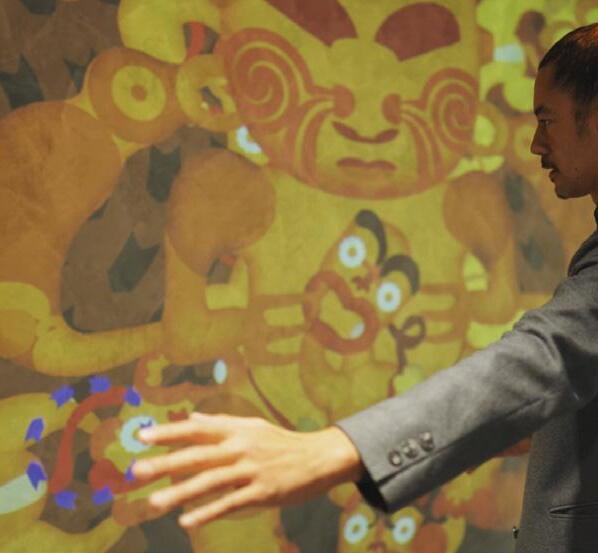
Human Resources editor
Kathy Young sat down with Dan Te Whenua Walker, Microsoft’s Global Co-Chair of Indigenous and 2025 New Zealand’s Leader of the Year, to learn about breaking barriers, changing corporate culture and enabling authentic opportunities.
The lobby wall at Microsoft’s New Zealand office features a stunning piece of digital Māori artwork created by Johnson Witehira called Te Aho Matihiko (the digital thread). It’s an artwork that responds to movement, with eyes that follow visitors around the room. It’s a fitting metaphor for Dan Te Whenua Walker’s work: bringing traditional culture to life in modern spaces while ensuring Indigenous voices are seen and heard.
TELL US ABOUT YOUR BACKGROUND
Icome from Taranaki, and I acknowledge that I’ve

emerged from underneath the protective cloak of my mountain, Maunga Titōhea. My mum has Māori connections through the many iwi around the maunga, as well as connections to Tūhourangi, Kahungunu o Te Wairoa, Rongomaiwāhine, Maniapoto and Waikato-Tainui. My mum moved to Ōtautahi Christchurch with the Māori Trade Training Scheme and met my dad, who is Pākehā with Scottish and Irish heritage that I’m proud of as well.
I grew up in Christchurch quite disconnected. In the 1980s,
it wasn’t really a place where we embraced Māori culture. I grew up disconnected from my language, my culture and my marae, and didn’t really feel like I fitted in. I didn’t feel like I belonged in te Ao Māori or te Ao Pākehā. For me, I really struggled. I didn’t see a future where I belonged, and I didn’t give any focus to school. I ended up dropping out with no qualifications and getting into a bit of trouble.
I was lucky that my whānau were there for me. I had two amazing women leaders: my Pākehā Nana, Nana Walker, and my Māori Nana, Nana Chick, whose name was Te Rau o Te Huia Taranaki. When I think of what they mean to me, I think of concepts like mana wāhine, a korowai or cloak of leadership and love that they gave me when I needed it most. Through them and the love of my parents, I finally wanted to put myself back together.
“ The places where we work can be platforms to do good for the communities that we love and serve. It doesn’t have to be just Māori; it can be any community you love.
HOW DID YOUR CAREER IN TECHNOLOGY BEGIN?
Ijoined Dick Smith Electronics because I loved anything involving tech and found I loved working with people: hiring, developing and growing people. When you help others grow, you can’t help but rise yourself. I became a store manager, area manager and then national sales manager at 26. I was headhunted by Noel Leeming, which gave me a national role where I could travel the whole country and start reconnecting with Taranaki for the first time.
My Nana Chick helped me get appointed to my marae committee, then I became the hapū representative for Tūwhakaaehu, and eventually joined my iwi board as Deputy Chair. I’ve been there for 17 years now. Then Samsung came to New Zealand, and I became their national
sales manager of consumer electronics. It grew from five people to 250. It was an amazing global role that allowed me to see New Zealand’s connection to Asia, which I found interesting. Later in my career, I started studying, and now have three degrees, including a Master’s in Advanced Leadership from Massey University, an MBA from the University of Auckland, and a Master’s in Māori and Indigenous Leadership, from Canterbury University. I’m working on a ‘From the Edge’ Masters with Stanford University and a PhD in Māori AI with Te Wānanga o Awanuiārangi.
CAN YOU EXPLAIN YOUR CURRENT ROLE AT MICROSOFT AND WHAT YOU’RE TRYING TO ACHIEVE?
When I joined Microsoft, very few Māori were employed globally. We connected with NAMER (Native Americans at Microsoft), Indigenous Canadians, Hawaiians and Samoans – about 40 of us in total –and launched Indigenous at Microsoft as the ninth employee resource group and the most recent one to launch in over 10 years. I was made Global Co-Chair along with Willow, who is Native American.
We started with about 40 people, and five years later, in August 2025, we had thousands of members. Our mission is to honour, share and celebrate Indigenous cultures within Microsoft and across Mother Earth, while shaping inclusive technology to empower future generations.

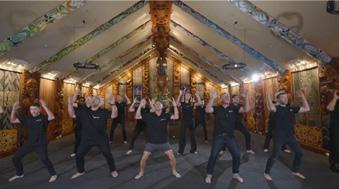
My role has two main parts. First is culture change. I’ve seen strategies trying to get Māori and Pasifika into corporate and technology, but they don’t contain anything about how they’re going to change their culture. They bring people in, then wonder why they don’t stick around, because they haven’t done any work on themselves as an organisation to change. The second part involves applying an Indigenous lens to our technologies. We’ve created the Aotearoa keyboard, which now has over 30,000 users. We’ve launched te reo Māori artificial intelligence (AI) that can live translate into te reo across all Microsoft products. We worked with Whetu Paitai to create a Māori Minecraft universe that’s free in the Education Edition, so anyone can learn about our culture.
WHAT ARE THE MAIN BARRIERS PREVENTING MĀORI FROM ENTERING TECH?
My research from my Master’s came through with three main barriers in the interviews. The first is cultural tax; when Māori come into spaces where there’s hardly any Māori representation, there’s quite a big load on their shoulders. They are generally asked to help with all things Māori, such as organising te wiki o te reo Māori, Matariki, pōwhiri, writing the whakataukī to help with proposals, and so on. Not only do they have to
be good at their job, but they have to be good at being Māori, too. And that takes its toll. I especially see this with Māori who are early in their career. The second is lack of trust. A lack of representation will always result in a lack of trust. If whānau and supporters aren’t supportive of your going into these spaces from a Māori perspective, that’s a big indicator for Māori about whether they want to go there.
The third is role models. If we don’t see our cousins, aunties, uncles and parents in this space, then it affects their confidence. Many of our role models are sports stars or from legal and government spaces. We have some great role models coming in tech and entrepreneurship, and we need to shine a light on them more.
WHAT IMPORTANT LESSONS HAVE YOU LEARNED ABOUT LEADERSHIP AND WORKING WITH PEOPLE?
Idiscovered I had ADHD later in life. I thought I was dumb, but it turns out I just had learning differences. The cookie-cutter approach of school didn’t work for me, and I see it with a lot of our kids now, including my 14-year-old son, who is so much like me.
This taught me that we all learn differently, we all teach differently, and we all come from different angles. I don’t have all the answers, and I’m totally okay with that,
because I’ve grown up not knowing the answers but being the person who can pull the answers from the group. The collective is always going to be much smarter than me as an individual. It’s a very Māori concept; we don’t go with the intent to give the answer, but the magic is in the wānanga space, the process of dialogue. There’s a whakataukī that says, “He kai a te rangatira, he kōrero, he kōrero, he kōrero”/ the sustenance of leadership is to communicate, to connect, and to collaborate”. That perspective captures so many more people than the topdown authoritarian approach.
“ I don’t have all the answers, and I’m totally okay with that, because I’ve grown up not knowing the answers but being the person who can pull the answers from the group. The collective is always going to be much smarter than me as an individual.
HOW CAN HR PROFESSIONALS ENABLE AUTHENTIC OPPORTUNITIES FOR UNDERREPRESENTED GROUPS?
The big thing I believe is that the places where we work can be platforms to do good for the communities that we love and serve. It doesn’t have to be just Māori; it can be any community you love.
My boss, Vanessa Sorenson [Microsoft New Zealand Country Manager], said to me in my interview: “Microsoft’s a platform company. We’re a platform to help you do the good work that you want to do”. I took that as a challenge.
The fact that even in one of the biggest companies in the world, someone from New Zealand with enough passion and drive – and by bringing people along the journey –can get executive buy-in to implement change at a global level shows what’s possible.
We have implemented pōwhiri for many people at Microsoft

New Zealand. When I first started, I told Vanessa I had to have a pōwhiri before I could start. They loved it so much that we do it for so many people who come to New Zealand and new starters; they get the same level of inclusion when they come here.
WHAT’S YOUR ADVICE FOR HR PROFESSIONALS IN THIS CHANGING LANDSCAPE?
Start thinking about what you can offer beyond knowledgebased tasks. What got us here – the cognitive intellectual skills – has become commoditised. AI is already eating jobs.
So what are we bringing that’s different? How can we be more than just a worker bee? Take a look at yourself in terms of what’s important for you and your community, but also look at your organisation. How can you add value in a way that’s based not on knowledge, but on connection and values?
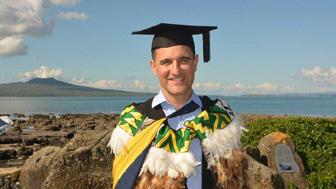
I’ve been unapologetic about being proud of who I am as Māori, and what really surprised me is that the world has totally embraced it. The key is making sure we don’t try to make it exclusive or say it’s just for one group. We want to build bridges and help everyone connect.
WHAT DOES THE FUTURE LOOK LIKE?
Ibelieve the future is about a values-led approach for everything – not just technology – but HR, business, entrepreneurship. That’s going to be the future, more so than the straight commercial approach. My dream is to get Māori into all these technology spaces so our young people can see themselves there.
As my mentor Pania TysonNathan says: “It’s not about commercialising culture, it’s about culturalising commerce”. How do we weave our culture into these spaces rather than

try to force it? We create spaces where people can see themselves, feel like they can back themselves, and know that we’ve got their back.
“ What got us here – the cognitive intellectual skills –has become commoditised. AI is already eating jobs. So what are we bringing that’s different? How can we be more than just a worker bee?

Dan Walker is a proud dad, husband and whānau member of ngā iwi o Ngāti Ruanui, Ngāruahine, Ngāti Kahungunu o Te Wairoa, Maniapoto, Tūhourangi, Waikato-Tainui. His main ties are to Taranaki. He is a Microsoft executive working at the intersection of Indigenous values and emerging technology. Through his PhD project, Te Rau o Te Huia (an AI kuia built to reconnect whānau with reo and whakapapa), and his role as CoChair of Indigenous at Microsoft, Dan is exploring how tikanga Māori can guide the design of AI systems. He is passionate about creating manaenhancing, culturally grounded digital futures for Aotearoa and beyond.

Terry McCaul, CFHRNZ and author of The Triple Knot: Designing and Leading Sustainable High Performance Organisations, lays down a challenge to HR professionals to test their own assumptions and offers a solution to guide organisations towards sustainable success.
High performance is so much more than just results and outputs. As many sports coaches will tell you, “winning ugly isn’t good enough”. As in, when it feels like you won by luck more than by design, things don’t feel as good. You want people to stick with you? Then you have to think wider.
HIGH AND LOW PERFORMANCE
O“ Winning ugly isn’t good enough.
ver the years, I have worked in many organisations. It felt very much to some that we had succeeded despite our best efforts to screw up, meaning we got things wrong due to unintentional design. You’ve probably seen a few places like
that. Staff are never satisfied, and managers are often incapable of following simple HR processes. Leaders are often invisible and, sadly, incompetent. Much of the time, HR bears the brunt, has to ‘clean up’, and spends way too much time on administrivia rather than really making a difference.
Sustainable, high-performance organisations are different. They are designed deliberately and purposefully to enhance high performance that is constant and consistent.
The good news is that these kinds of deliberate and purposeful organisations are

around. I’ve been in some of them. I can even claim a hand in creating some of them. Something they all have in common is their ability to change and shift in a timely way.
What makes them so good at this? I mean, change is change, right? We’ve been doing it for centuries. We are familiar with all of the models and processes to follow. We also know our business, and we have a wealth of reporting and data. We can see how we are going, and we can reliably predict how we’ll continue. We have highly knowledgeable and educated managers and leaders. Our staff are skilled and capable
people. Basically, we have everything that high-performing organisations have. Why then does it feel so difficult for us? Especially over the past decade. The answer to that question lies in our paradigms about work, organisational life, and how organisations are changed.
Aparadigm is a distinct pattern of thought, perspective, or set of ideas that guides beliefs about a particular subject. Paradigms set the boundaries for how things should work or be. Paradigms help us establish policies and processes that, without them, would compromise performance.
Times occur when paradigms need to be challenged and sometimes shattered, perhaps due to profound operating environment changes that force us to think and act differently. When this happens, it can have a devastating effect on an organisation. Paradigms can be shifted, as we, who have tried to do so, have found. But this is not easy. This is especially so if those paradigms are founded in and reinforced by what has worked in the past, even though evidence suggests that things need to change.
Here’s a clear example. Before the invention of the telephone (1876), everyone knew it was impossible to speak to someone far away. Alexander Graham Bell offered to sell his patents to Western Union, the world’s leading telegraph company. They said no, “…the idea is idiotic… why would any person want to use this device when he can send a message to the telegraph office in any large city in the United States?”.
Ahh, the power of paradigms. The world of work is in the midst of a profound period of change, and many paradigms are under threat. We are all aware that the world of work has changed. So why are organisations still being designed and led in much the same way as they have for the past few centuries?
We are locked into our organisational paradigms, many of which are no longer relevant or are fast becoming less relevant. Nine to five? Five days a week? Go to the office?
Leaders are really struggling to understand what to do. They look to the HR sector for help, and, sadly, much of the time, HR leaders are governed by the same paradigms. I hope, at least, we understand how best to shift. To what, though? We must also guard against replacing a false paradigm with another.
There has never been a more opportune time for HR to move forward in a more strategic manner. If we are to help our organisations become fit for the new world of work, then we shouldn’t be “aligning people strategy with business strategy”. We should be advocating that they are the same thing. We need to encourage the development of sustainable, high-performance organisations.
Here’s the challenge: HR leaders need to first have the courage to question their own paradigms. We need to stop grasping at ideological solutions and build on the basis of knowledge, facts and real data, and not beliefs and mediadriven popular tropes, such as generational stereotyping.
This framework is built on real knowledge of people. Knowledge that doesn’t come from surveys, publications or consultants, but instead from building an intelligence system based on real people interactions, such as manager and employee conversations, customer contacts, governance feedback, and the constant scanning and awareness of all constituents within the operating environment.
Customers, shareholders, regulators, the public and, most critically, employees, have much more demanding expectations than ever before. Organisations
don’t have the luxury of deciding which element of performance to compromise in favour of the others. An internally focused people strategy is an oxymoron to a sustainable, highperformance organisation.
A sustainable, high-performance organisation is designed and led in a way that enables it to focus on the few really critical things that contribute to organisational success. It understands the interrelationships between four domains that are most important in getting there and staying there.
• Organisational sustainability: It has the ability to continue to operate the daily business and invest in future performance at the same time. This means it has to ensure money and resources are used wisely in the development of future capabilities, especially workforce. It also monitors, understands and constantly meets the expectations of all other key stakeholder groups.
• Culture: It cultivates an adaptive, strong and strategically appropriate culture. It ensures all employees understand what is really important and are part of that. It does this, not from values statements hanging on the wall, but from organisational leaders behaving in a collective and consistent manner that drives the behaviours within others.
• Workplace design: It has deliberately designed the
three main workplaces to encourage humans to perform: physical workplace, virtual workplace and psychological workplace. All are enabled to reinforce high performance in sync with each other. People must feel safe and productive in all of these environments, no matter where or when a person is operating within one or more of them.
• Employment model: It attracts, deploys and retains people with the capabilities and attributes to ensure ongoing success. The organisation understands the three distinct employment value propositions that make people want to work and stay there. The individual proposition, unique to each person (eg, money or career growth), the vocational proposition, or “why do I want to do this type of work?”, and the organisational proposition, “why do I want to work for this particular employer?”. A genuine understanding of each person rather than stereotyping or generalising about the workforce is crucial, especially as people’s needs shift over time.
Each of these critical areas can, and should be, deliberately designed and set up to complement each other in ways that optimise wholeof-organisational success. The essential element to achieving this is through
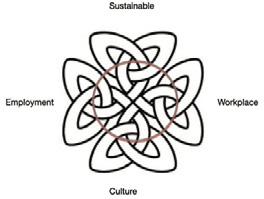
collective leadership and deep intelligence systems that provide real-time knowledge on how each area is working, and most especially how each area impacts the others.
To be a sustainable, highperformance organisation, you need an operating model that ensures all of these four critical areas work in harmony with each other. That is what the circle in the middle indicates. The Senior Leadership Team is responsible for continuously monitoring and adjusting the system to maintain balance.
This model is designed from a strategic HR world view. It’s all about people. All stakeholders are, of course, people. This makes HR ideally placed to guide the thinking needed to succeed.
“ The things that gave you success today are unlikely to give you success tomorrow.
Are you up for it? Making this real isn’t easy. HR will need to overcome big paradigms. Remember, the things that gave you success today are unlikely to give you success tomorrow. The only way that would happen is if the world around you stopped moving and changing.
Every change endeavour has its own challenges. After spending most of my adult life doing this, I have learned a few things that may help.
• Despite all of the ‘change expertise’ out there, 70 per cent of all change management initiatives fail. Avoid the ‘recipe for change’ approach. The important thing to making progress is to treat people as real humans. Not just pieces in a process. Processes don’t care if they are changed. People do. Let them help you design the pathway forward.
• Culture change is perhaps the biggest paradigm of all, especially for leaders and HR. Avoid the whole traditional culture change programme, and especially
creating another set of company values. It is critical to recognise diversity in the workplace and enable your teams to identify their own sets of values that have meaning to their particular areas of work. Different disciplines demand different values of focus that drive them to achieve. Most especially, the senior leadership team need to do this as a work group for themselves. Remember, organisational culture is built around the behaviours of those in leadership.
• Keep things simple.
• Another major paradigm for HR (this will be heresy): drop the focus on ‘engagement’. Give people something to do to contribute to making change. Involve your people. Make them feel that they are actively making a better world.
• Make progress transparent. People feel included when they know what is happening. Talk to them, in their teams. Show them clear, simple indicators. Make it about them.
Much of this may make you nervous. But it actually works. I said that your paradigms would be challenged. But what an opportunity to make real, strategic progress.
Are you still up for it? Of course you are.
“ Remember, organisational culture is built around the behaviours of those in leadership.

Terry McCaul, CFHRNZ;
is a thought leader in organisational culture and leadership. He has been instrumental in significant change programmes in New Zealand businesses over the past four decades. A qualified and experienced company director, he has been a CEO and C-Suite executive at 14 different organisations across the private and public sectors. His work on building sustainable high-performance cultures earned him best presenter awards at United Nations Economic Commission for Europe conferences in Oslo (2018) and Geneva (2019). Terry retired from full-time work in 2024, and his acclaimed business novel, The Triple Knot-Designing and Leading Sustainable High Performance Organisations, has been helping leaders develop and implement new thinking in the rapidly changing world of work.

Check out our Organisational Membership
• Consolidate your team’s membership into a simple, single package
• Transfer membership when staff members leave or change roles
• Discounted bulk rate
• All staff get access to HRNZ member discounts for HR Essentials for People Leaders and HR Foundations courses ($120 - $370 pp) For more information please contact Laura Cook via Laura.Cook@hrnz.org.nz

Brian Yee, Managing Director of MSH Consulting, explores the common pitfalls that prevent HR from becoming a strategic partner, and offers a practical framework for positioning HR as a critical driver of organisational success.
Like every leadership function, HR should produce a strategy that outlines its vision, strategic priorities and contribution to organisational success. Effective HR strategies should clearly articulate how the HR team will enable the organisation to achieve its wider strategic goals, providing a roadmap for how HR will contribute to organisational outcomes.
Many HR strategies fail to gain traction because they aren’t meaningfully aligned with the organisation’s broader strategy. This often happens when the business fails to engage HR early in the strategy development process, and when HR teams don’t think broadly enough about the scope and focus of the HR strategy, within the context of creating value for customers.
“ Too often, HR is consulted only after the organisation’s strategy is set, leaving it to react rather than shape the direction of the organisation from a people lens.
We think it’s important that HR teams find ways to connect their strategies so that they are a critical driver of organisational success and play a crucial role in the performance of organisations. They must partner
HR COMPONENTS
EXAMPLE HR FUNCTIONS
SHAPING
with the business so that they can proactively align their focus. They can do this by translating business objectives into clear strategic requirements for HR to deliver on. In our experience, we see common pitfalls that lead to HR strategies not aligning with organisational strategies, and therefore limiting HR’s contribution to organisational success.
One of the common reasons why HR strategies fail to align with the organisation’s strategies is that HR has a lack of early involvement in strategy development, or, in some cases, is not involved at all. Too often, HR is consulted only after the organisation’s strategy is set, leaving HR teams to react rather than shape the direction of the organisation from a people lens. Because HR isn’t involved in the strategy development process early enough, organisation strategies often do not define the role of HR clearly enough. Therefore, it is hard to see the connection between people, strategy and performance. Many organisation strategies lack detail on the people and capability requirements, leaving HR unsure how to connect its priorities. Clearly and explicitly defining people requirements
Provide insights that significantly improve business decisions
Workforce planning
Capacity modelling
Organisational structure design
Change management
Organisational culture and values
in the organisation’s strategy enables HR to align its strategy by connecting HR initiatives and work plans directly to the priorities of the organisation.
For example, if an organisation’s strategy identifies global expansion as a main focus area to drive growth, HR can align its strategy with specific people initiatives that enable this growth, such as acquiring cross-cultural leadership talent or building a culturally adaptable workforce.
Even when HR is aligned with an organisation’s strategy, the perception of the role of HR remains a significant barrier. HR is often viewed as an enforcer of rules rather than a strategic partner, leading to disengagement by the business or apathy about how HR can help. We often see HR being characterised as the ‘policy police’ or a ‘service provider’ because its focus on HR disciplines is too narrow or unbalanced. To shift this perception, HR needs to broaden its focus and demonstrate how it drives business success.
When orienting their strategy, HR teams often frame their
SAFEGUARDING
Provide assurance that critical business risks are being managed
Developing HR frameworks and policies (eg, recruitment policy, performance framework, health and safety)
Training in how to apply HR frameworks and policies
Monitoring compliance
SERVICING
Systematically deliver transactional services
Disputes resolution
Payroll and leave administration
Recruitment advice
Onboarding and exiting employees
plans around the more transactional ‘nuts and bolts’ HR functions rather than the strategic workforce capabilities that the business needs to succeed. A useful way for HR teams to broaden their focus, so they can become more of a business partner, is to categorise HR functions using a ‘shaping, safeguarding, servicing’ framework.
We find that HR teams often fall into the trap of focusing on ‘safeguarding’ and ‘servicing’, because, without a clear strategy, they default to transactional or control-type services. Lacking clarity on their strategy means they are forced into a reactive mindset, rather than being able to proactively shape the organisation. To become a trusted business partner, HR teams and their strategies must place a greater emphasis on ‘shaping’ and outline how these functions align with the HR requirements outlined in the organisation’s strategy.
CANDIDATE PRIMARY CUSTOMER
BUSINESS EXECUTIVES
Another reason why HR strategies can fail is uncertainty about who the primary customer of the HR team is. A primary customer is defined as “the people who your strategy focuses on serving the needs of”. Choosing a single primary customer is important so that you can focus on their unique needs. Trying to serve multiple customers creates a lack of focus, and resources are spread thinly across many areas. As a result, no customer is served well. We sometimes come across HR teams who are adamant that they have multiple internal customers within the organisation whose needs they are delivering on (eg, business executives, line managers and employees). This blurs the focus of their strategy because staff at different levels of an organisation typically
STRATEGIC FOCUS
Enabling the executive team to achieve the organisation’s strategic goals by aligning people capability to business priorities.
have different preferences and requirements from HR. Even worse, HR teams may believe they are meeting the needs of the same external customers as the rest of the organisation. In these situations, we highly recommend that the HR team selects a single customer who is the primary focus of the strategy.
Fundamentally, there is no right or wrong choice when deciding on a primary customer, but the customer you select will provide a different strategic focus and have different implications for the focus of an HR team.
Most of the HR teams we work with select business executives as their primary customers because it enables HR to become a trusted strategic partner within the organisation and play a pivotal role in achieving organisational outcomes. Furthermore, this does not mean that other customers will not be served entirely. Choosing business
IMPLICATIONS FOR HR
HR is seen as a strategic partner and enabler of business performance.
HR gains credibility and influence at the executive table but may risk being seen as less accessible to employees or overly focused on business metrics.
LINE MANAGERS
Empowering line managers to lead effectively by providing tools, frameworks and support that help them attract, develop and manage high-performing teams.
HR is viewed as a trusted adviser for managers, recognised for helping leaders make better people decisions and manage teams effectively.
This strengthens HR’s operational relevance but may reduce its perceived strategic influence with executives.
EMPLOYEES
Creating an engaging employee experience that supports individual growth, wellbeing, career development and staff retention.
HR is seen as an enabler of individual potential, focused on growth, wellbeing and engagement across the organisation.
This builds staff loyalty and retention but risks HR being seen as more service-oriented than strategic.
executives will result in benefits to managers and employees lower down in the organisational hierarchy, because HR influence at the ‘top table’ will mean clearer direction and the implementation of initiatives that ultimately benefit people in the wider organisation.
FOCUSING THE HR STRATEGY ON BUILDING HR’S OWN CAPABILITY, TOO
Afurther limitation of many HR strategies is an overemphasis on delivering business-as-usual services at the expense of building capability to deliver strategic value. The diagram right shows the intercept between HR strategies and organisation strategies.
“ Without deliberate investment in HR capability building, HR remains reactive, with limited ability to improve performance or deliver better organisational outcomes.
HR teams need to focus on two essential elements to contribute to the wider organisation’s strategy: undertaking capabilitybuilding initiatives and delivering enabling services. Too often, though, they primarily focus on only delivering enabling services. HR teams are sometimes hesitant to invest in capabilities – such as new systems, processes or staff training –because these initiatives can disrupt established routines and create extra work for employees across the organisation. Many organisations also hesitate to invest in HR capabilities because they fear that doing so diverts resources from customerfacing initiatives, when, in fact, strengthening HR’s capabilities is one of the most powerful ways to enhance the organisation’s overall performance and customer impact.
It is only when HR strategies focus on both elements that they can truly contribute to delivering on the critical elements of the organisation’s strategy. Without deliberate investment in HR capability
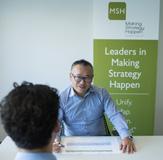
building, HR remains reactive, with limited ability to improve performance or deliver better organisational outcomes in the future.
I2
DELIVER ENABLING SERVICES (EG, RECRUITMENT, PAYROLL)
ORGANISATION STRATEGY
RESULTS
The results the organisation is aiming to achieve
The explicit service needs of the customer
The core business as usual processes critical to organisation success
CAPABILITY
Investment in people, information, infrastructure and systems
n summary, an effective HR strategy is more than a set of policies or processes; it’s a critical driver of organisational success. By engaging early in strategy development, positioning HR as a trusted business partner, focusing on a primary customer, and investing in long-term capabilities, HR can move from a reactive, transactional function to a proactive, strategic enabler. When these elements are aligned, HR not only supports the organisation’s goals but also creates measurable impact across the organisation, enhancing people performance, culture and workforce capability.

Brian Yee is the founding Director of MSH Consulting and has been providing strategic consulting advice to New Zealand organisations for over 25 years. MSH Consulting partners with business leaders to shape, design, implement and sustain strategies that deliver lasting impact. Brian has worked alongside HR teams across a range of medium and large organisations, helping them craft HR strategies that not only align with but actively drive business success. For more information, visit www.mshconsulting.co.nz.
Our regular columnist, Aidan Stoate, New Zealand CEO at Inspire Group, shares his heartfelt insights into leading people
“ What enables your organisation to achieve success, and what inhibits it?
It’s a relatively straightforward question, but often the answer is complicated. Recent economic conditions have forced many businesses into a strategic rethink about how their products, services, systems or processes can be optimised to enable successful outcomes in more competitive and challenging environments. Yet, while organisations often focus on structural or operational improvements, sustainable achievement still largely depends on people, and their capability, adaptability and engagement.
This is where Human Resources plays an essential, strategic role, not just as an administrative function, but as an enabler of opportunity and a driver of organisational success. The paradox for most organisations, however, is this: while now is the most important time to invest in people, it is also the hardest time to justify (and demonstrate a clear return on) that investment.
So, how can HR be the enabler of opportunity despite this profound challenge?
Transition from an organisation that Does Learning to a Learning Organisation
Current economic realities might restrict investment in traditional learning and development programmes, but they also create a compelling opportunity to shift towards a more iterative and sustainable learning culture. Through our work at Inspire Group, we are already seeing many organisations embrace the transition away from flashy, content-heavy, theory-based learning events towards more dynamic, enduring, conversationled learning. This shift represents far more than a cost-saving measure. It reflects a deeper mindset change from viewing learning as a series of isolated interventions to embedding it as part of everyday work.
Another main enabler lies in alignment. People are more engaged when they understand not only what their organisation is trying to achieve, but why it matters, and how their specific role contributes to it. HR can help leaders articulate purpose more clearly and translate strategy into meaningful, individual contributions. This connection between personal purpose and organisational goals drives motivation, ownership and discretionary effort, the foundations of sustained achievement. A healthy byproduct of this is a clearer value proposition that also generates opportunity in talent acquisition and management.
For HR, showing leadership means being willing to do the difficult things well: to have the uncomfortable conversations, to challenge
outdated mindsets, and to make decisions that balance compassion with commercial reality. In uncertain times, it’s easy for organisations to retreat into risk aversion, focusing on efficiency at the expense of opportunity. But HR leadership means leaning into that tension and advocating for people when it’s hardest to do so, proving that long-term success is built not just on systems, but on trust, purpose and growth. This might mean redesigning performance frameworks to value learning and collaboration over hierarchy. It might also mean confronting critical cultural issues that haven’t been previously addressed.
When HR leads with this kind of authenticity and courage, you model the very behaviour you seek to inspire across the organisation. You become the true enabler of opportunity.

Aidan Stoate is the New Zealand CEO of Inspire Group, an awardwinning learning design consultancy that delivers world-class solutions to organisations globally. Aidan has a passion for helping organisations improve their culture and performance through innovative learning and development interventions. As an ICFaccredited organisational coach, Aidan provides subject-matter expertise for the design and delivery of leadership programmes, while leading the Inspire Group New Zealand business across all projects and disciplines. Having led organisations and teams in the United Kingdom, South-East Asia, North America and Australasia, Aidan brings a nuanced perspective while promoting inclusive, engaging and contextualised solutions that drive genuine behaviour change and strategic benefits.
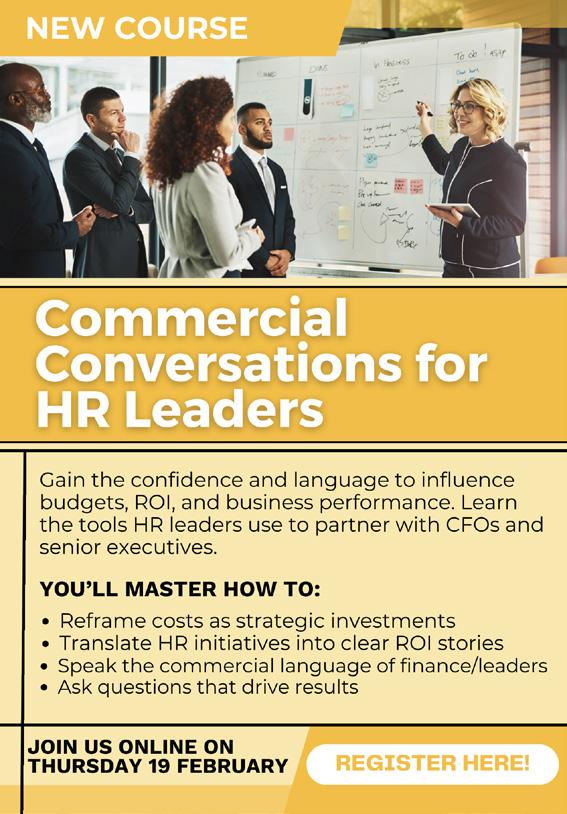
comms@hrnz.org.nz
hrnz.org.nz
nz .linkedin.com/company/hrnz
instagram.com/hrnzphotos

